Nationality Italian Period Arte Povera | Name Alighiero Boetti Role Artist | |
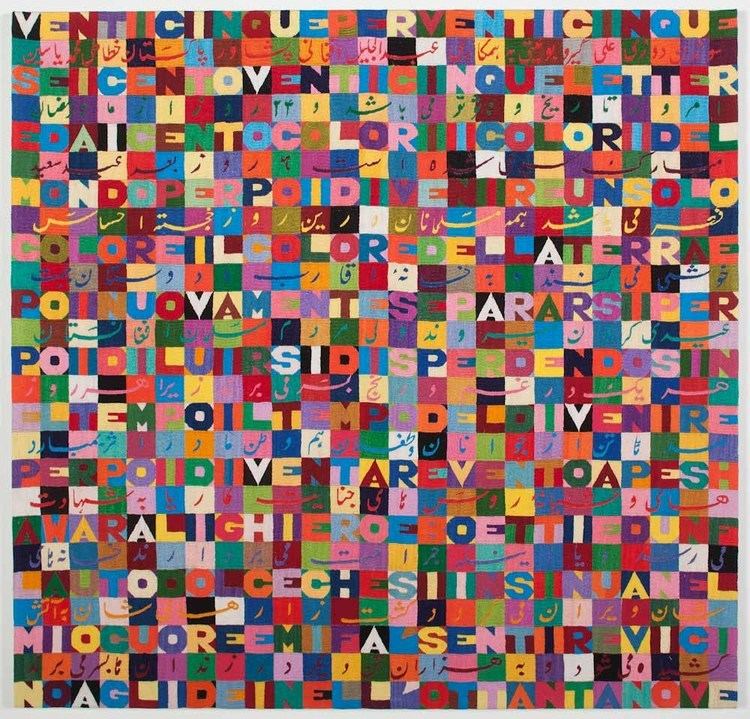 | ||
Full Name Alighiero Fabrizio Boetti Died February 24, 1994, Rome, Italy Artwork Mappa, Tutto, Ononimo People also search for Francesco Clemente, Luca Cerizza, Norman E. Rosenthal | ||
Tateshots francesco clemente on alighiero boetti
Alighiero Fabrizio Boetti known as Alighiero e Boetti (16 December 1940 – 24 February 1994) was an Italian conceptual artist, considered to be a member of the art movement Arte Povera.
Contents
- Tateshots francesco clemente on alighiero boetti
- Alighiero boetti
- Background
- Life
- Arte Povera
- 1972 1994
- Embroideries
- Exhibitions
- Select exhibitions
- Key Works Selection
- Art Market
- Authentication issues
- References
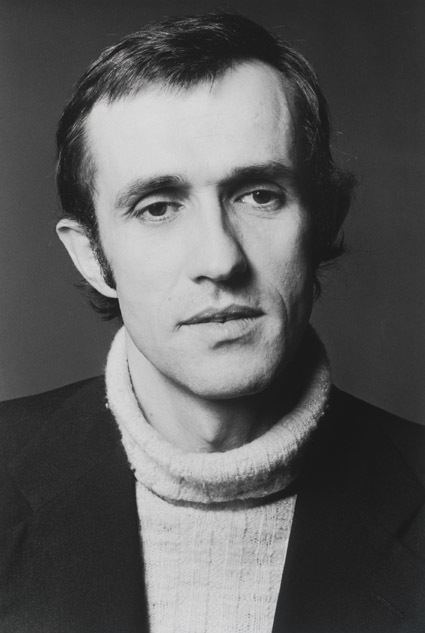
Alighiero boetti
Background
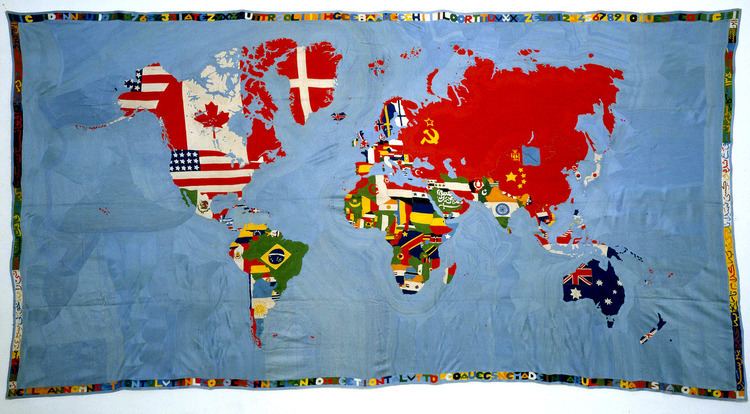
Boetti is most famous for a series of embroidered maps of the world, Mappa, created between 1971 and his death in 1994. Boetti's work was typified by his notion of 'twinning', leading him to add 'e' (and) between his names, 'stimulating a dialectic exchange between these two selves'.
Life
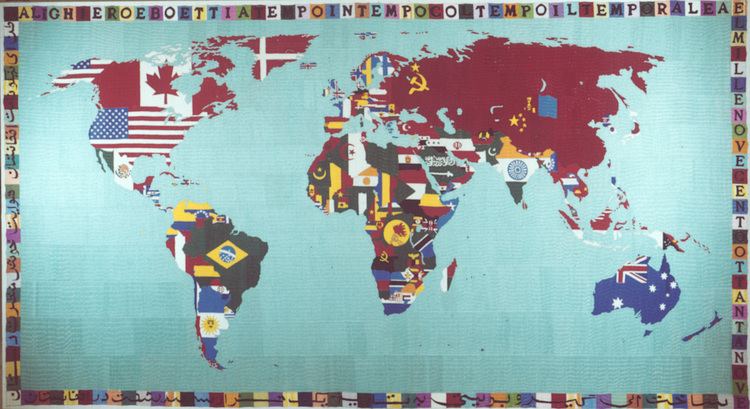
Alighiero Boetti was born in Turin, to Corrado Boetti, a lawyer, and Adelina Marchisio, a violinist. Boetti abandoned his studies at the business school of the University of Turin to work as an artist. Already in his early years, he had profound and wide-ranging theoretical interests and studied works on such diverse topics as philosophy, alchemy and esoterics. Among the preferred authors of his youth were the German writer Hermann Hesse and the Swiss-German painter and Bauhaus teacher Paul Klee. Boetti also had a continuing interest in mathematics and music.
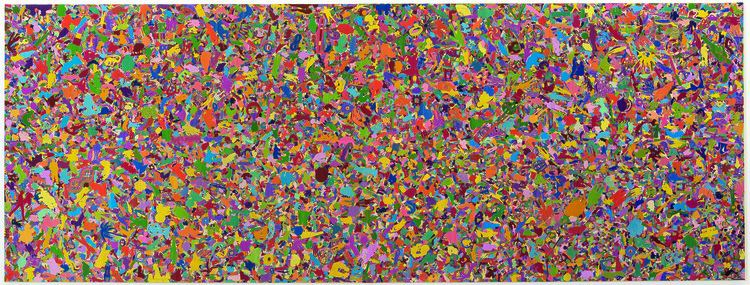
At seventeen, Boetti discovered the works of the German painter Wols and the cut canvases of Argentine-Italian artist Lucio Fontana. Boetti's own works of his late teen years, however, are oil paintings somewhat reminiscent of the Russian painter Nicolas de Staël. At age twenty, Boetti moved to Paris to study engraving. In 1962, while in France he met art critic and writer Annemarie Sauzeau, whom he was to marry in 1964 and with whom he had two children, Matteo (1967) and Agata (1972). Working in his hometown of Turin in the early 1960s amidst a close community of artists that included Luciano Fabro, Mario Merz, Giulio Paolini, and Michelangelo Pistoletto, among others, Boetti established himself as one of the leading artists of the Arte Povera movement. From 1974 to 1976, he travelled to Guatemala, Ethiopia, Sudan. Boetti was passionate about non-western cultures, particularly of central and southern Asia, and travelled to Afghanistan and Pakistan numerous times in the 1970s and 1980s, although Afghanistan became inaccessible to him following the Soviet invasion in 1979. In 1975, he went back to New York.
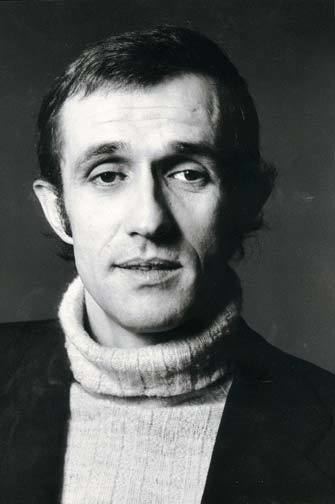
Active as an artist from the early 1960s to his premature death in 1994, Boetti developed a significant body of diverse works that were often both poetic and pleasing to the eye while at the same time steeped in his diverse theoretical interests and influenced by his extensive travels.
He died of a brain tumour in Rome in 1994 at the age of 53.
Arte Povera
From 1963 to 1965, Boetti began to create works out of then unusual materials such as plaster, masonite, plexiglass, light fixtures and other industrial materials. His first solo show was in 1967, at the Turin gallery of Christian Stein. Later that year participated in an exhibition at Galleria La Bertesca in the Italian city of Genoa, with a group of other Italian artists that referred to their works as Arte Povera, or poor art, a term subsequently widely propagated by Italian art critic Germano Celant.
Boetti continued to work with a wide array of materials, tools, and techniques, including ball pens (biro) and even the postal system. Some of Boetti's artistic strategies are considered typical for Arte Povera, namely the use of the most modest materials and techniques, to take art off its pedestal of attributed "dignity". Boetti also took a keen interest in the relationship between chance and order, in various systems of classification (grids, maps, etc.), and non-Western traditions and cultural practices, influenced by his Afghanistan and Pakistan travels.
An example of his Arte Povera work is Lampada annuale (Yearly Lamp) (1966), a single, outsized light bulb in a mirror-lined wooden box, which randomly switches itself on for eleven seconds each year. This work focuses both on the transformative powers of energy, and on the possibilities and limitations of chance - the likelihood of a viewer being present at the moment of illumination is remote. In 1967, Boetti produced the piece Manifesto, a poster listing the names of artists that make up Boetti’s creative background.
In 1967, for the i Colori series, Boetti made monochrome paintings in which he sprayed these paints on metal or masonite supports, recording the numbers and fanciful names of the colours in superimposed prefabricated cork letters. Different thematic groups emerged as Boetti combined their names with other names, race track names for instance (Oro Longchamp and Verde Ascot) or distant place names (Rosso Palermo and Beige Sahara). In 1971 Boetti made a diptych with two dates: the first, 16 December 2040, is the 100th anniversary of his birth; the second, 11 July 2023 the date he predicted would be his own death.
In January 1968, Boetti returned to the two-dimensionality of paper with publishing a poster in an edition of 800, containing a list of 16 Italian artists of his own generation. Next to each name were two, three, or four symbols out of a set of eight, signs whose meanings out of a set of eight, signs whose meanings were held secret but had been recorded in a letter deposited with a notary. Later that year Boetti produced an edition of 50 postcards bearing a reproduction of one of his recent works. In 1969, he created Cimento dell’armonia e dell’invenzione and with the Lavori postali series, based on the scanning of time and on the laws of mathematical permutation. By using an existing system (the post office), Boetti incorporated the element of chance in his work. Dossier Postale (1969–70) consists of a series of letters which were sent to 26 well-known recipients, primarily artists (Giulio Paolini, Bruce Nauman), art critics (Lucy Lippard, Arturo Schwarz), dealers (Konrad Fischer, Leo Castelli), and collectors (Giuseppe Panza, Corrado Levi) active at the time. Boetti sent the envelopes to imaginary addresses, thus each letter was returned to the artist undelivered, demonstrating Boetti’s preoccupation with improbability and chance. Untitled (Victoria Boogie Woogie), 1972, is made up of 42 framed postal collages, each containing 120 self-addressed, stamped envelopes of seven stamps per envelope. The letters were all mailed by the artist from different cities to himself in Turin. The number 5040, or (120 x 42 panels), or (7 x 6 x 5 x 4 x 3 x 2 x 1), was the number of permutations that could be derived from a sequencing of the seven Italian stamps, totaling 200 lire of postage.
1972-1994
Boetti disassociated himself from the Arte Povera movement in 1972 and moved to Rome, without, however, completely abandoning some of its democratic, anti-elitist, strategies. In 1973, he renamed himself as a dual persona Alighiero e Boetti (“Alighiero and Boetti”) reflecting the opposing factors presented in his work: the individual and society, error and perfection, order and disorder. Already in his double-portrait I Gemelli begun in 1968 and published as a postcard, Boetti had altered photographs so that he appeared to be holding the hand of his identical twin. He trained himself to write and draw ambidextrously.
Boetti often conceived of an idea for a work of art but left its design and execution to others. He thus often collaborated with both artists and non-artists, giving them significant freedom in their contributions to his works. For instance, one of the better known types of his works consists of colored letters embroidered in grids ("arazzi", meaning wall hangings or tapestries) on canvases of varying sizes, the letters upon closer inspection reading as short phrases in Italian, for instance Ordine e Disordine ("Order and Disorder") or Fuso Ma Non Confuso ("Mixed but not mixed up"), or similar truisms and wordplays. To create these pictures, Boetti worked with artisan embroiderers in Afghanistan and Pakistan, to whom he gave his designs but increasingly handed over the process of selecting and combining the colors and thus deciding the final aesthetic look of the work.
Similarly, in the lavori biro (ball pen paintings), he would invite friends and acquaintances, to fill large colored sections of the multi-part work by ball pen, typically alternating between a man and a woman from one sheet to another. Boetti made his first ballpoint ink drawings in 1972–73 and continued through the late 1980s. Many of the works in this series contain puzzles, puns and linguistic codes, wherein letters of the alphabet run horizontally or vertically along the margin of the sheet. I sei sensi (The Six Senses) (1973), is part of a series of drawings done in code. An alphabet is laid out on the left side of the paper, forming an index. Commas, laid out horizontally, correspond to each letter of the alphabet. The “meaning” of the piece may be read by following the progressively arranged commas in relation to the letters. In the case of I sei sensi, Boetti has spelled out in Italian the five senses — vedere (to see), gustare (to taste), toccare (to touch), dire (to hear), odarare (to smell) — and one added by the artist: pensare (to think). The largest of all Boetti's Biro works are the four versions of Ononimo (1973), with their progressions of eleven separate panels, each hand-coloured in biro (two in blue biro and two in red).
His most ambitious project is a large embroidered piece titled Classificazione dei mille fiumi piu lunghi del mondo (Classification of the thousand longest rivers in the world (1977). In characteristically blocky letters, this work spells the names of the world's 1,000 longest rivers in descending order of length. It is based on a list that required more than seven years of research by Boetti and his first wife, Anne Marie Sauzeau, an art critic, and that is known to many scientists as the Boetti List. Initially inspired by Albert Hochheimer's 'Novel of Big Rivers' (first published in Italy in 1956), this extensive project culminated in 1977 with the publication of a thousand-page book documenting the thousand longest rivers of the world and in the creation of two large and unique embroidered tapestries that each listed the results of their research in descending order. These two tapestries, one white on a green background (now in the Museum für Moderne Kunst, Frankfurt am Main), the other made of coloured dots on a white background (now in the MoMA, New York) were complemented by four distinct and individual works - each executed in a different colour and always intended to stand alone from each other - that collectively constitute a complete list of the thousand rivers.
In his Aerei (1977), or Airplanes series, Alighiero e Boetti left as negative space line drawings of modern and historical airplanes. Originally culled from popular magazine sources, these mural-size images construct an illusionary space of action and movement. Following an invitation by Hans Ulrich Obrist, the artist published six of his watercolour drawings in Austrian Airlines' in flight magazine ‘Sky Lines’. To accompany this publication, jigsaws of the images were produced, and were available to passengers on the flights at this time.
His interest in the media led Boetti to collaborate with the daily newspaper “Il Manifesto”, published in Rome, for which, everyday for a year, he executed a drawing, thus accomplishing his idea of a serial work for the general public. In 1983 he created the series of pencil drawings traced from the covers of popular magazines. The same year he created the large wall mosaic in white ceramic for the external façade of the Art Gallery of the California State University, Northridge, for which he used cardboards with drawings made by the students following his indications.
Embroideries
Perhaps best known is Boetti's series of large embroidered maps of the world, called simply Mappa. After the Six-Day War in June 1967 the artist began to collect newspaper covers featuring maps of war zones. Comprising twelve sheets of copper, each engraved only with the single outline of a map, Dodici forme dal 10 guigno 1967 (Twelve Shapes Starting from 10 June 1967) (1967-1971) graphically catalogues some of the world's most serious political crises between 1967 and 1971, beginning, as its title suggests, with the territories occupied by Israel at the time of the Six Day War on 10 June 1967. He then asked his wife to embroider the shapes from the June 1967 map. The embroidery, consisting of three patches of brown wool on an otherwise empty piece of cloth, looks like a "work in progress". Within a relatively short time he subsequently visited Africa, South America, the United States and East and Central Asia. He pondered the idea of the first large-scale Mappa during his second voyage to Afghanistan in 1971, resulting in a series of woven world maps entitled Territori Occupati. Between 1971 and 1979 he set up the One Hotel with his friend and business partner Gholam Dastaghir in Kabul as a kind of artistic commune and created large colourful embroideries, the most famous of these were the Mappa, world maps in which each country features the design of its national flag. In 1971, Boetti commissioned women at an embroidery school in Kabul to embroider his first map. He initially intended to make only one but went on to commission roughly 150 of them in his lifetime, with no two possessing exactly the same dimensions.
Boetti’s maps reflect a changing geopolitical world from 1971 to 1994, a period that included the collapse of the Soviet Union and the fall of the Berlin Wall. Embroidered by up to 500 artisans in Afghanistan and Pakistan, the maps were the result of a collaborative process leaving the design to the geopolitical realities of the time, and the choice of colours to the artisans responsible for the embroidery. The maps delineate the political boundaries of the countries; some nations, such as Israel, are not represented because the Taliban regime of Afghanistan did not then recognize their existence. When embroiderers ran short of a particular color thread and had to substitute another, oceans came out yellow or red instead of blue. In one map, the sea is unexpectedly coloured pink rather than blue, as landlocked Afghans had no tradition of mapping, certainly not of oceans. The border texts contain dates or details relative to the work’s production, Boetti’s signature and sayings, as well as excerpts from Sufi poetry.
"For me the work of the embroidered Mappa is the maximum of beauty. For that work I did nothing, chose nothing, in the sense that: the world is made as it is, not as I designed it, the flags are those that exist, and I did not design them; in short I did absolutely nothing; when the basic idea, the concept, emerges everything else requires no choosing." Alighiero e Boetti, 1974
It was not until 1975 that Boetti created the first works entitled Tutto and not until 1982 that his first large scale Tutto embroidered pictures were made. The first Tutto (all square in format) were given the title Pack and these were the first embroidered Tutto to take the form by which the series is now known. Each one made use of a selected variety of intersecting shapes of 'all' the separate objects and things that make up the world, with each shape coloured, arbitrarily, by the Afghan women who embroidered them. Boetti chose the various objects to be depicted from an extensive range of sources including encyclopaedias, schoolbooks, magazines, newspapers, and other lexica. Such an approach ensured the wide range of motifs; but the degree of this range and its scope was always ultimately determined by Boetti himself with many stencils made of certain favourite motifs so that they could be reused in later Tutto designs.
The brightly colored Arazzi works are embroidered pieces made in various sizes that depict sentences drawn from poetry, wisdoms from around the world, or sayings invented by Boetti himself. The Arazzi grandi, containing messages in both Italian and Persian, are each distinct, recording the date when they were created, and containing an elaborate internal code that prescribes the order of the sentences on display. They contrast geometric European letters and flowing Persian calligraphy in checkerboard patterns, alternating bands, grids or cruciform shapes. The dates, carefully noted on each Arazzi grandi, mark a point of captivation for Boetti, as he was deeply interested in the concept of time and its inevitable passing.
The embroidery of each map normally took one to two years and, in some cases, much longer due to geopolitical events. Following the closure of the Afghan border, Boetti was forced to abandon this practice and work remotely from Italy. This work began in his studio in Rome, with the artist outlining the countries in felt-tip pen onto linen, before sending the cloth framework to Afghanistan. The invasion of Afghanistan by Russian troops in 1979 shifted production completely from Kabul to Peshawar in Pakistan, where the group of Afghan women had taken refuge and where Boetti was only able to reconnect with them through middlemen. It also halted production completely until 1982, with only a few maps being made between 1982-1985 During the 1980s Boetti visited Pakistan to meet the men organizing the embroidery. As a European male, however, Boetti was not allowed to visit the camps. He therefore asked photographer Randi Malkin Steinberger, with whom he had collaborated on the book Accanto al Pantheon in Rome, to go to Peshawar in 1990 to photograph the craftswomen at work.
A chief example of this series, Mappa del Mondo, 1989 ("Map of the World, 1989"), is on view in the permanent collection of the Museum of Modern Art in New York (see Key Works).
Exhibitions
Having shown in Milan and Turin, Boetti was invited by Harald Szeemann to participate in the seminal exhibition "Live in your Head. When Attitudes Become Form" in 1969. Boetti had his first US solo exhibition in New York at John Weber Gallery in 1973. In 1978, he held an anthological exhibition curated by Jean-Christophe Ammann at the Kunsthalle Basel that featured historical works alongside more recent ones. He continued to show throughout Italy and the United States until his premature death. He was the subject of a retrospective in 1992 that traveled to Bonn and Münster, Germany, and Lucerne, Switzerland. He has been honored post-humously with several large-scale exhibitions, most notably at the Galleria Nazionale d'Arte Moderna, Rome (1996); the Museum für Moderne Kunst in Vienna in 1997; the Museum für Moderne Kunst in Frankfurt am Main in 1998; Whitechapel Gallery, London (1999); and Kunstmuseum Liechtenstein, Vaduz. The artist took part in Documentas 5 (1972) and 7 (1982) and the Venice Biennale (1978, 1980, 1986, 1990, 1995). In 2001, the Venice Pavillon was completely dedicated to Alighiero e Boetti’s work. In 2012, for the exhibition Game Plan, a significant number of works have been lent to the MoMA by Tornabuoni art Gallery.
Select exhibitions
Key Works (Selection)
Art Market
In 2010, Boetti's Mappa (1989) was sold at Christie's London for £1.8 million ($2.75 million). That same year, one of his ball pen paintings, Ononimo (1973), sold for £1 million ($1.6 million), also at Christie's London. In 2011, Tutto (1988) set a new record for Boetti's work at £1.3 million ($2 million).
Alighiero Boetti is represented by Sprüth Magers Berlin London, Gagosian Gallery and Tornabuoni Art. Sprüth Magers organized shows in Berlin, London, Cologne and Munich over the past decade, and in New York, Barbara Gladstone and Marianne Boesky have both hosted Boetti shows. Tornabuoni Art held an exhibition of the artist in 2010 in his parisian gallery, which included about 90 pieces. In 1995, the Archivio Alighiero Boetti, seated in Rome, was created for the issuance of certificates of authenticity for works by Boetti.
Authentication issues
In 2008, lawsuits were filed between Sperone Westwater Gallery (the artist's primary dealer at the time) and the Archivio Alighiero Boetti (and some family members) over the authenticity of 15 works exhibited and sold by the gallery its 2002 show "Simmetria Asimmetria". In a January 2008 suit by the archive against the gallery in Milan, the archive sought declaratory judgment that it is not liable to the gallery for not authenticating the works in dispute, and additionally claims that the gallery violated its "moral rights" by exhibiting, publishing, and selling works of art attributed to Boetti. Sperone Westwater, in return, sued the Boetti Archive in the United States District Court for the Southern District of New York for what it alleges is a broad scheme to discredit it by capriciously questioning the authenticity of Boetti artworks it has shown and sold in the United States; this included one that was purchased by the Art Institute of Chicago. In the New York suit, Sperone Westwater asked the judge to make a declaratory judgment that the archive has no moral rights claims and also seeks damages "for the Defendants' injuries to the gallery's business and reputation," on counts of breach of implied covenant of good faith and fair dealing, negligent misrepresentation, and interference with business relations.
